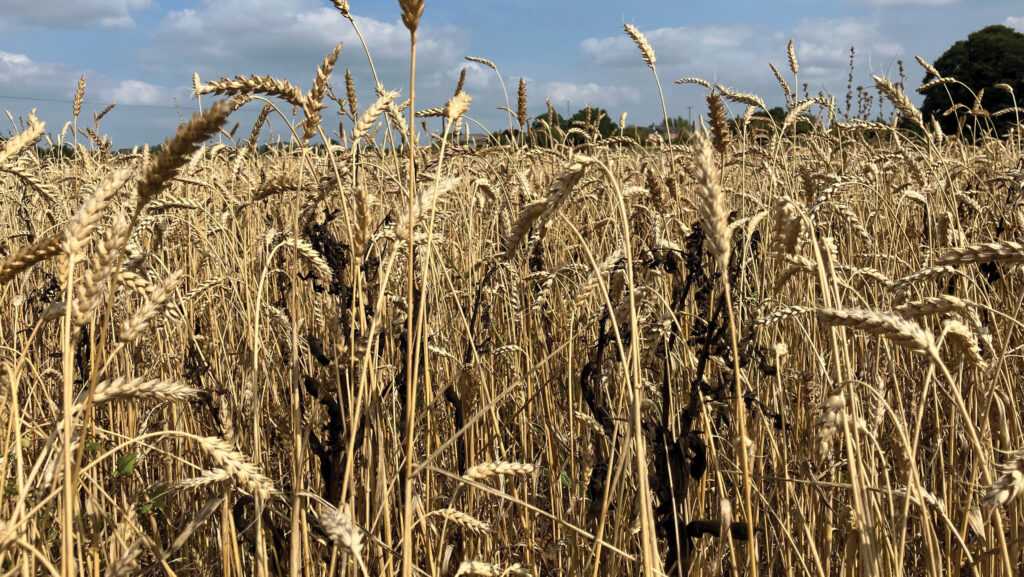Video: Organic spring wheat and bean bicrop hits hefty premium
 Mariagertoba spring wheat and beans © MAG/Emma Gillbard
Mariagertoba spring wheat and beans © MAG/Emma Gillbard An organic crop of spring milling wheat intercropped with beans is set to achieve a hefty milling premium after a successful harvest at Devon farmer George Greed’s farm near Exeter.
The hard, red population wheat variety Mariagertoba, known for its superior baking quality, was grown alongside a crop of Fanfare spring beans, achieving between 13-16% wheat protein, despite zero artificial nitrogen use.
Population wheats are genetically diverse varieties from a range of different parent varieties, making them more adaptive to unpredictable weather, nutrient supplies and disease pressure.
See also: Farmer Focus: Bad yields, bad prices and bad weather
Watch the video and read the rest of the report below.
The crop came off at 14.5% moisture, with a yield of 3.35t/ha, explains combine operator and farmworker Rob Jones.
“The wheat is grown as part of a south-west grain project involving farmers, millers and bakers producing flour in a water mill based in Shaftesbury in Dorset.
“The bakers are going absolutely mad for it,” he says.
About Mariagertoba
Mariagertoba has a high gluten index and impressive resistance to mildew, rust and common bunt.
It was developed by Danish plant breeder Anders Borgen from 15 different parentages.
The variety takes it name from the Canadian province Manitoba as it resembles the hard, red spring, marketed as Manitoba flour.
A standard wheat seed rate of 180kg/ha and a maximum of 75% of a standard bean rate was used, aiming for 25 plants/sq m for spring beans.
“The beans are grown as a companion crop and it is an added bonus if they make the human consumption market.
“Crops are then separated using a Law Denis gravity separator,” says Rob.
Establishment
A total of 19ha of the crop was planted this season, following a four-year herbal ley, which was overwinter bale-grazed by the farm’s herd of cattle.
With a spring application of muck and manure, the land was then shallow ploughed and drilled with a 3m Kuhn power harrow.
“We usually go for a March sowing date, but the spring was just too wet to even think about drilling then, so we planted in April instead.
“We aim to get the crop off to a good start, which is why we need to focus on establishment,” says Rob.
Volunteers of the previous herbal ley have established beneath the crop canopy this season, acting as an additional weed suppressant and biodiversity boost.
A clover understorey also established in patches across the field, offering a welcome nitrogen fixation benefit.
Other species including plantain and kale were also present.
Rob notes that because of the slightly greener material in the crop, having the sun out when combining was absolutely essential.
“You’ve got to have the sun on the crop when any green material is present as this can otherwise cause issues with the crop feeding into the header as it can tangle and wrap,” he says.
The farm previously ran a Class Lexion combine, but recently made the switch to a traditional straw walker model.
A Class Tucano combine was the machine of choice.
George notes rotary combines are less suited to organic crops due to the inconsistent feed intake into the header, which can tangle.
He finds the straw walkers on the other performs better and tangles less.
This autumn, the land will be planted to a winter wheat population wheat called YQ (Yield and Quality), alongside a crop of winter beans.
It will receive another dose of cattle muck before being ploughed and power harrowed.
The YQ wheat population was developed by crossing 20 different varieties at Wakelyns Agroforestry by professor Martin Wolfe and the Organic Research Centre.
Intercropping benefits
Diversity in the cropping system is a massive positive, says Devon farmer George Greed, which is why all cereals are now intercropped with a legume.
He says intercropping wheat and beans provides the following benefits:
- Weed suppression
- Disease control
- Improved protein content of wheat
- Targets the premium organic milling market
- Crops alive with bees, butterflies and other beneficial insects
- Takes the risk out of growing the crop
- Reduces risk of pest attack
- Eliminates artificial inputs

